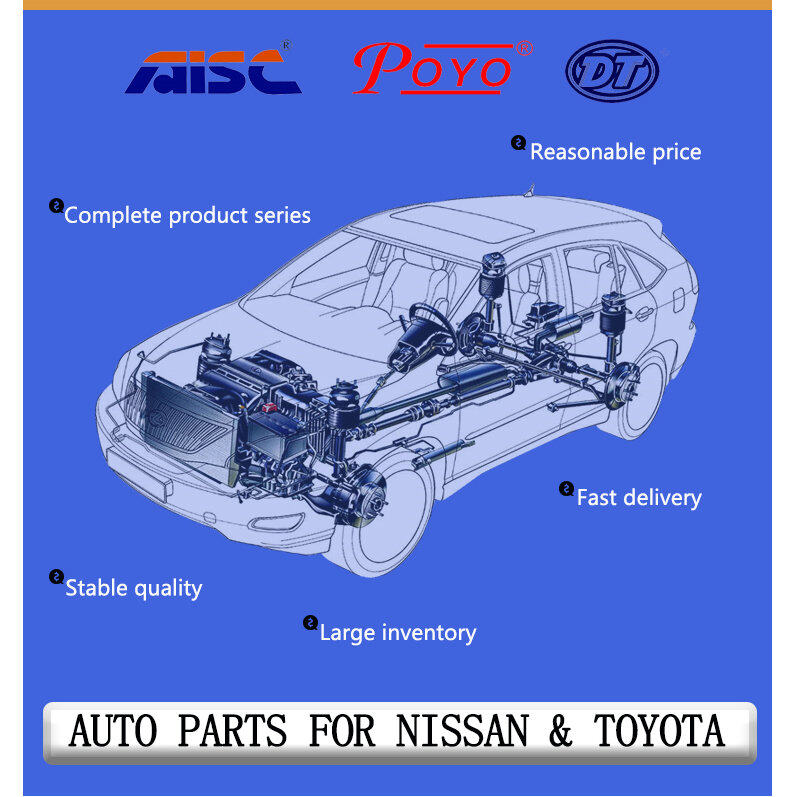Email format error
Email cannot be empty
Email already exists
6-20 characters(letters plus numbers only)
The password is inconsistent
Email format error
Email cannot be empty
Email does not exist
6-20 characters(letters plus numbers only)
The password is inconsistent

News

Understanding Toyota Strut Mounts: Everything You Need to Know
When it comes to maintaining your Toyota, one crucial component that often goes unnoticed is the strut mount. While it might not be as glamorous as a turbocharged engine or as flashy as a new paint job, the Toyota strut mount plays a vital role in your vehicle’s suspension system. In this blog, we’ll dive into what a strut mount is, why it’s important, and how to maintain and replace it.
What Is a Toyota Strut Mount?
A Toyota strut mount is a component of your car’s suspension system that connects the strut assembly to the vehicle's body. It’s located at the top of the strut and acts as a bridge between the strut and the vehicle's chassis. Essentially, the strut mount serves three main functions:
- Mounting the Strut: It securely attaches the strut to the car’s body.
- Supporting the Weight: It helps support the weight of the vehicle and absorbs impacts from the road.
- Allowing Rotation: It allows the strut to rotate as the steering wheel is turned, enabling smooth and precise steering.
Why Is the Strut Mount Important?
The Toyota strut mount is more than just a connection point; it’s a critical part of the vehicle’s suspension system. Here’s why it’s important:
Ride Comfort: A good strut mount helps maintain the ride comfort of your vehicle by absorbing shocks and vibrations from the road. If the mount is worn out or damaged, you may notice increased road noise and a rougher ride.
Steering Performance: The strut mount plays a significant role in steering precision. If it’s not functioning correctly, you might experience issues with steering stability and alignment.
Safety: A faulty strut mount can impact your vehicle’s handling and safety. A worn-out mount may lead to excessive play in the suspension, which can compromise your ability to control the vehicle effectively.
Signs of a Faulty Toyota Strut Mount
Knowing the signs of a faulty strut mount can help you address issues before they become serious problems. Here are some common symptoms:
Clunking or Rattling Noises: If you hear clunking or rattling noises coming from the suspension area, it could be a sign that the strut mount is worn out or damaged.
Uneven Tire Wear: Faulty strut mounts can lead to misalignment, which may cause uneven tire wear. If you notice that your tires are wearing out unevenly, it’s worth checking the strut mounts.
Steering Problems: If you experience difficulty steering or notice that the steering wheel is off-center, the strut mount could be to blame.
Vibration or Rough Ride: Excessive vibrations or a rough ride can indicate that the strut mount is not absorbing shocks as it should.
Visible Wear: Sometimes, you might be able to see visible signs of wear on the strut mount, such as cracks or leaks.
How to Inspect and Replace Toyota Strut Mounts
If you suspect that your Toyota strut mount needs attention, here’s a step-by-step guide on how to inspect and replace it:
1. Inspecting the Strut Mount
- Visual Inspection: Begin with a visual inspection. Look for any signs of wear, such as cracks, tears, or leaks. Check if the mount is securely attached and if there are any loose or damaged components.
- Listening for Noises: Drive the vehicle over bumps and listen for any unusual noises. Clunking or rattling sounds can indicate a problem with the strut mount.
- Check for Vibration: Pay attention to any excessive vibration or a rough ride, which can be a sign of a faulty strut mount.
2. Replacing the Strut Mount
- Raise the Vehicle: Safely lift the vehicle using a jack and secure it with jack stands. Make sure the vehicle is stable before you begin working.
- Remove the Wheel: Take off the wheel to access the strut assembly.
- Detach the Strut Assembly: Remove the bolts securing the strut assembly to the vehicle. Carefully detach the strut assembly from the strut mount.
- Replace the Strut Mount: Remove the old strut mount and replace it with a new one. Ensure that the new mount is properly aligned and securely attached.
- Reassemble the Strut Assembly: Reattach the strut assembly and tighten the bolts to the manufacturer’s specifications.
- Reinstall the Wheel: Put the wheel back on and lower the vehicle. Ensure everything is properly secured and torqued to specifications.
Tips for Maintaining Your Toyota Strut Mount
To ensure the longevity and performance of your Toyota strut mount, follow these maintenance tips:
Regular Inspections: Have your strut mounts inspected regularly as part of your vehicle’s routine maintenance. Early detection of issues can prevent more significant problems down the road.
Avoid Rough Roads: Whenever possible, avoid driving on rough or poorly maintained roads. Excessive jarring can put additional stress on your strut mounts.
Address Issues Promptly: If you notice any symptoms of a faulty strut mount, address the issue promptly. Ignoring it can lead to further damage and increased repair costs.
Professional Help: If you're not comfortable inspecting or replacing the strut mount yourself, seek the help of a professional mechanic. They have the expertise and tools to handle the job correctly.
Conclusion
The Toyota strut mount may not be the most talked-about component of your vehicle, but it’s essential for maintaining a smooth ride and precise steering. Understanding its role, recognizing signs of wear, and knowing how to inspect and replace it can save you from more significant issues and ensure your vehicle remains in top condition.
By taking care of your strut mounts and addressing any problems promptly, you’ll help keep your Toyota running smoothly and safely. So, the next time you hear a strange noise or feel a rough ride, remember that your strut mounts might be the culprit—and it might be time for a check-up.
With this guide, you now have a better understanding of Toyota strut mounts and how to care for them. Safe driving!

